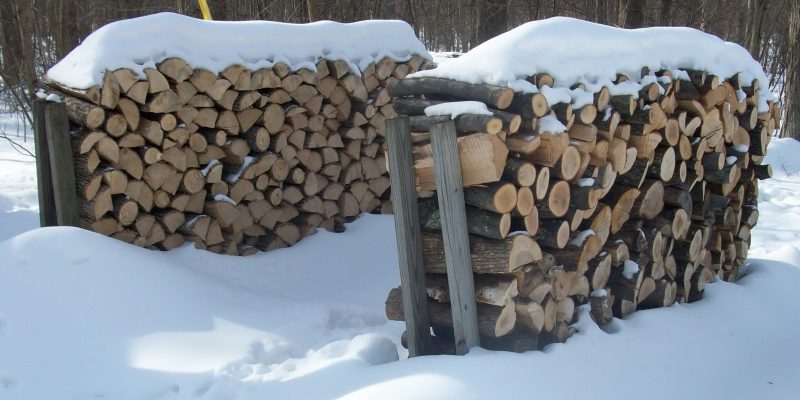
Ashwood wet or ashwood dry
A King shall warm his slippers by.
All plants with cellulose will provide heat when burned. For fuelwood, the more cellulose the more heat value. Gardiner is well populated with hardwood trees, which contain lots of densely packed cellulose and provide the best firewood. Any small, woodland patch of trees or fence row or roadside clumps of scraggly trees would benefit from some light thinning of poorly formed trees. Turn them into firewood.
Not sure which ones to cut? The excerpts included here, from “The Firewood Poem,” by Lady Celia Congreve, circa the 1930s (with additions and modification by the author), helps to figure it out. (The advice of a consultant forester is well worth the nominal fee, too!)
As the rhyme implies, ash is a species well worth the effort to obtain. Gardiner residents with a supply of white ash for their heating plans will be well provided for as the weather turns colder and ash is a tree with a number of serious insect problems, so any dying or dead ash should be cut and burned to help delay the spread of these pests.
Elmwood burns like
churchyard mold,
Ev’n the very flames are cold.
Not true, of course; this ditty probably relates more to the difficulty in splitting elm than to its heat value, which is medium. Gardiner is full of the bleached skeletons of dead elms, killed by the Dutch elm disease, spread by a tiny beetle. As with ash, burning dying elms will help delay the inevitable with others of this species.
Birchwood flames are
cheery and bright,
Alas, they will not
last the night.
Poems aside, no logs, unless very massive, will “last the night,” but oaks, beech, birch, maple and especially hickory produce uniform flames and steady, glowing coals. For relative heat value, hickory is the standard by which all other wood is measured. That, with its pleasant aroma, makes it another very desirable wood for heating purposes. Maple and birch are in the group of desirable hardwoods, and though neither will burn as hot nor last as long, relatively, as oaks and hickory, they still make very good firewood.
Red, or soft maple, is probably the most common species in Gardiner. It grows quickly on wet or dry sites, is easy to cut and split, dries well, and burns with good heat value, if not for long. Many of the former farm fields abandoned years ago are thick with this species.
Hemlock’s known for the
sparks it throws,
Wakes you up when
you would doze.
Softwood species—hemlock, pine, spruce, fir, cedar—contain pitch and burn rapidly, producing few coals. They do best when a short, hot fire is desired. Mixing softwoods with hardwoods, especially when lighting a fire, is a good way to get a fine blaze going. Split softwood is excellent kindling.
Fir logs burn too fast
Blaze up bright and do not last.
If you don’t have ready access to your own trees, purchasing firewood is the next alternative. In years past, a cord of firewood meant a stack of four foot long logs in a pile four feet high and eight feet long. Typically, it weighs about five thousand pounds. Even if available today, few people want to handle four foot long logs. You may find some wood for sale as a “Face Cord.” Here, the “face” of the stack is the same—four by eight feet—while the logs are typically sixteen inches, which fit in most wood burning stoves. Today, most firewood is sold and delivered by the truckload, or as long lengths from a logger, for the homeowner to cut up. Fine work, that, for those handy with a chain saw and log splitter. It’s hard to gauge the pile dumped by the delivery truck, but just know that a full cord of wood, 4x4x8 contains 128 cubic feet of wood, including gaps and air spaces.
Beechwood fires are
bright and clear,
If the logs are kept a year.
Much is made of “seasoned” firewood, but all wood, wet or dry, will burn. The difference is that some heat value is lost in driving out the moisture from freshly cut, or green, logs; heat is lost up the chimney as steam or vapor. Green wood may also coat the chimney with tar, which may catch on fire itself—a dreaded “chimney fire.”
Cutting, splitting, and stacking logs hastens the natural drying of the wood, and though the poem calls for a year, much moisture is lost in the first few months—even logs cut this fall will give good heat later in the winter. Covering the top of a stack with tarps may aid in drying it, but do not wrap it up. That will only trap moisture inside. Better to let sun, wind and time dry the wood naturally. I’ve noticed that the first few layers of split wood on a stack act as a sort of roof, keeping all the rest below them dry.
Poplar gives a bitter smoke,
Fills your eyes and
makes you choke.
Applewood will scent
your room
with an incense like perfume.
Burning furitwood may produce nice aromas, but only in an open fireplace or fire pit. Otherwise the smoke just dissipates up the chimney. Most fruitwood is dense, and contains good heat values.
Finally, advice from the old Forester: One log can’t burn, two won’t, three might, four will. Enjoy your firewood, and keep warm this winter.
